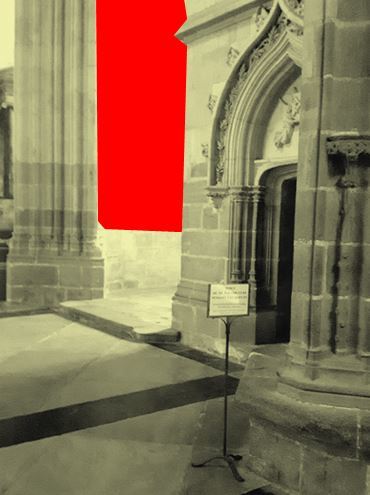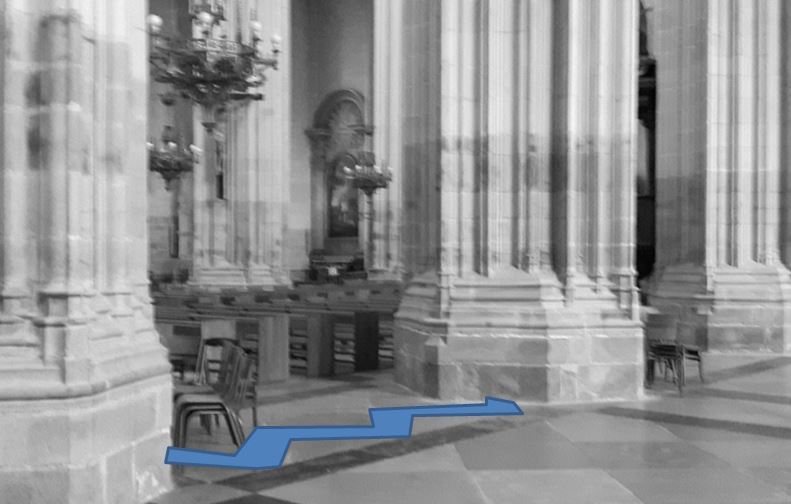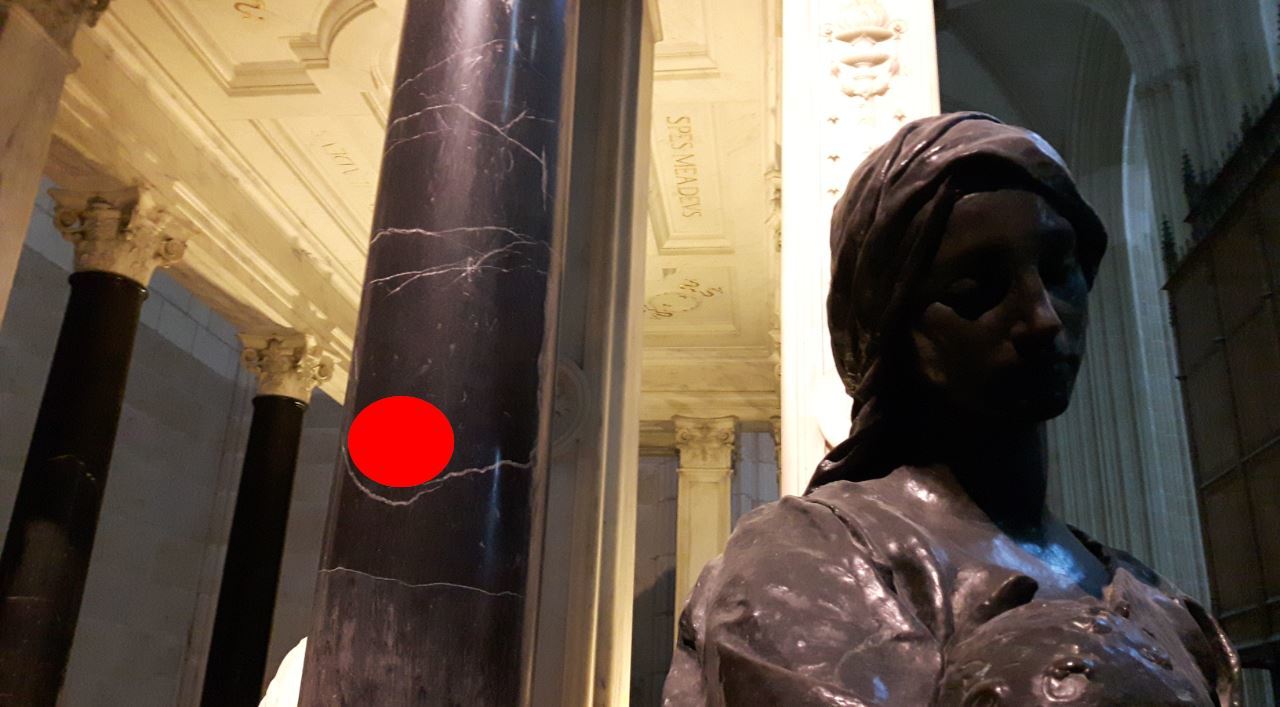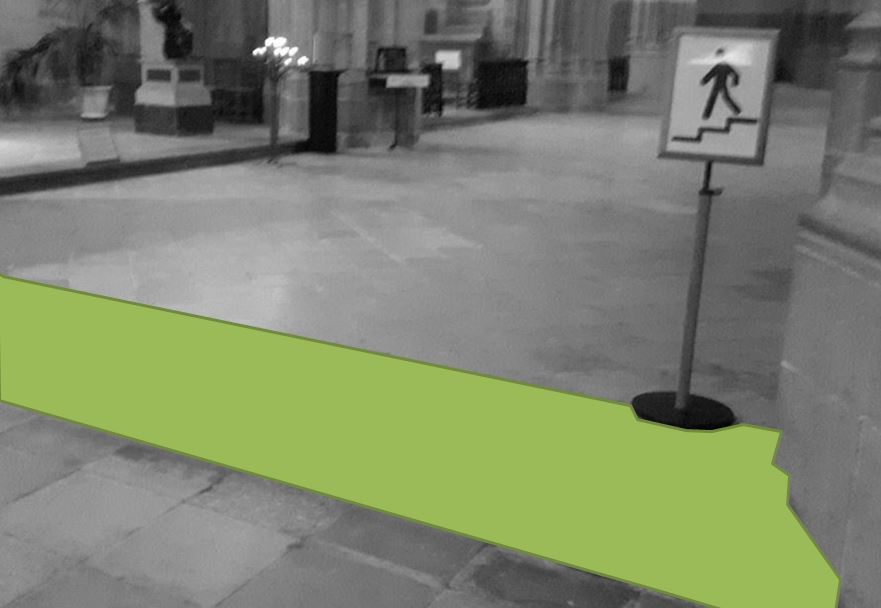
La Earthcache / The Earthcache
► Le site d'observation : La cathédrale Saint-Pierre-et-Saint-Paul
La cathédrale Saint-Pierre-et-Saint-Paul (appelée aussi localement « cathédrale Saint-Pierre ») est une cathédrale catholique romaine située sur la place Saint-Pierre de Nantes.
Longue de 103 mètres, sa construction s’est étalée sur 457 ans, de 1434 à 1891.

Les maîtres d'oeuvre de sa construction ont choisis les matériaux géologiques les plus nobles pour faire de cette cathédrale un monument religieux d'exception.
Qu'elles soient d'origines locales ou beaucoup plus lointaines, les roches ayant contribué à son édification sont un livre ouvert sur la vie de notre Terre, permettant en un seul lieu d'y découvrir ses particularités et les traces de son histoire au travers des Ères.
Ce premier épisode va nous permettre de découvrir la diversité de ces roches et leurs caractéristiques.
► Le Granite
Le granite est une roche plutonique magmatique à texture grenue, cette texture étant à l'origine de son nom dérivé du latin granum, grain.
Il est le résultat du refroidissement lent, en profondeur, de grandes masses de magma intrusif restés coincés dans la croûte terrestre qui formeront le plus souvent des plutons.
Les minéraux cristallisent alors dans un certain ordre : d'abord les micas noirs (biotite), puis les feldspaths (blancs ou roses), enfin les quartz.

Le granite, principalement composé de Silicates est une roche très dure (dureté 7 sur l'échelle de Mohs).
Du fait de cette dureté, cette roche est souvent utilisée comme matériau de construction pour les parties de monuments soumises à l'usure ou nécessitant une résistance particulière (soubassements).
► Le marbre blanc de Carrare
Au sens géologique moderne, un marbre est une roche métamorphique dérivant d'un calcaire ou d'une dolomie sédimentaire ayant été transformée par métamorphisme régional ou de contact.

Dans ce processus de transformation de la roche originelle, les structures sédimentaires sont effacées et la roche carbonatée recristallise en un amas de cristaux de calcite et/ou de dolomie.
Les intercalations argileuses, les minéraux détritiques ou les oxydes minéraux présents dans le carbonate originel donnent alors au marbre diverses colorations et veinages polychromes très esthétiques.
C'est le cas du marbre de Carrare ; exploité depuis environ 2.200 ans, il est célèbre dans le monde entier pour sa blancheur qui présente peu de veines.
Ce marbre présente un grain très fin, quasi-invisible à l'oeil nu.

► Les calcaires marbriers
Dans l'art et l’architecture le terme « marbre » englobe aussi historiquement beaucoup d'autres roches calcaires dures ayant une composition et des qualités équivalentes mais qui ne sont pas considérées comme des vraies marbres au sens géologique aujourd'hui.
~ Le "Marbre" rouge
Ce calcaire marbrier, d'origine non répertoriée, présente de nombreuses veinures appelées marbrures. Les veines et les coloris sont généralement dus à des inclusions d'oxydes métalliques.
Ces veinures sont des veines de calcite pure qui se sont dissoutes puis recristallisées dans des fractures.
Cela donne un ensemble de couleur allant du blanc au rouge profond sous la forme de dégradés qui s’entremêlent.
Cette coloration rouge est due à la présence d'un oxyde de fer, l'hématite, dont la concentration dans la roche conditionne la coloration du cristal.

Ce calcaire marbrier ne présente pas de traces de fossiles et présente un grain fin, il est certainement d'origine détritique, avec comme clastes d'origine des argiles ou des sables très fins.
~ Le "Marbre" noir
Ce calcaire marbrier, d'origine non répertoriée, présente une coloration noire très intense inhérente aux sédiments qui ont formés la roche lors de la diagenèse.
A la différence du marbre rouge, cette roche présente des traces de fossiles marins, permettant de déterminer le milieu d'origine de cette roche (mers chaudes peu profondes) ; il a également subit des contraintes postérieures (et peut être un début de métamorphisme) se matérialisant par des fissures comblées par de la calcite pure blanche.

Ce calcaire marbrier est utilisé dans la Cathédrale Saint Pierre pour des pavements et dans certaines monuments et sculptures.
► Le Tuffeau
Le tuffeau blanc est une pierre calcaire (craie) micacée ou sableuse à grain fin, de couleur blanche à texture homogène.
Le mot tuffeau vient du grec tophos qui désigne une pierre friable. C'est effectivement une pierre tendre, ce qui en facilite son travail dans la construction.
Cette roche se caractérise également par une forte porosité (jusqu'à 50% du volume de la roche), ce qui peut expliquer sa tendresse vis à vis d'autres roches.
L’analyse minéralogique montre que dans le tuffeau blanc de Saumur les principales phases cristallines sont la calcite CaCO3 et le quartz SiO 2.

Du fait de son caractère esthétique, cette roche est utilisée pour les murs de la Cathédrale, à l'exception des soubassements qui sont réalisés dans une roche plus dure pour assurer la solidité de l'édifice.
► The observation site: St. Peter and Paul's Cathedral
St. Peter and St. Paul's Cathedral (also known locally as "St. Peter's Cathedral") is a Roman Catholic cathedral located in St. Peter's Square in Nantes.
103 meters long, its construction spread over 457 years, from 1434 to 1891.
The masters of its construction have chosen the most noble geological materials to make this cathedral an exceptional religious monument.
Whether of local origins or much more distant, the rocks that contributed to its construction are an open book on the life of our Earth, allowing in one place to discover its peculiarities and traces of its history through Era.
This first episode will allow us to discover the diversity of these rocks and their characteristics.
► The Granite
Granite is a magmatic plutonic rock with a grainy texture, this texture being at the origin of its name derived from the Latin granum, grain.
It is the result of the slow, deep cooling of large masses of intrusive magma that are trapped in the Earth's crust and will most often form plutons.
The minerals then crystallize in a certain order: first black micas (biotite), then feldspars (white or pink), finally quartz.
Granite, mainly composed of Silicates is a very hard rock (hardness 7 on the Mohs scale).
Because of this hardness, this rock is often used as a building material for parts of monuments subject to wear or requiring special resistance (foundations).
► The white marble of Carrara
In the modern geological sense, a marble is a metamorphic rock derived from a limestone or sedimentary dolomite that has been transformed by regional metamorphism or contact.
In this process of transformation of the original rock, the sedimentary structures are erased and the carbonate rock recrystallizes into a mass of calcite and / or dolomite crystals.
Clay interlayers, detrital minerals or mineral oxides present in the original carbonate then give the marble various colorings and polychromatic veins very aesthetic.
This is the case of Carrara marble; operated for about 2,200 years, it is famous all over the world for its whiteness which presents few veins.
This marble has a very fine grain, almost invisible to the naked eye.
► Marble limestones
In art and architecture the term "marble" also historically encompasses many other hard limestone rocks of equivalent composition and quality, but are not considered true marbles in the geological sense today.
In this process of transformation of the original rock, the sedimentary structures are erased and the carbonate rock recrystallizes into a mass of calcite and / or dolomite crystals.
Clay interlayers, detrital minerals or mineral oxides present in the original carbonate then give the marble various colorings and polychromatic veins very aesthetic.
This is the case of Carrara marble; operated for about 2,200 years, it is famous all over the world for its whiteness which presents few veins.
This marble has a very fine grain, almost invisible to the naked eye.
~ The red "Marble"
This limestone marbrier, of unlisted origin, has many veins called mottles. Veins and colors are usually due to inclusions of metal oxides.
These veins are veins of pure calcite which are dissolved and recrystallized in fractures.
This gives a set of colors ranging from white to deep red in the form of interlocking gradients.
This red coloring is due to the presence of an iron oxide, the hematite, whose concentration in the rock conditions the coloring of the crystal.
This marble limestone has no traces of fossils and has a fine grain, it is certainly of detrital origin, with clasts as origin clays or very fine sands.
~ The black "Marble"
This marble limestone, of unlisted origin, presents a very intense black coloration inherent to the sediments which formed the rock during the diagenesis.
Unlike red marble, this rock has traces of marine fossils, allowing to determine the original environment of this rock (shallow warm seas); it has also undergone posterior stresses (and may be a beginning of metamorphism) materializing through cracks filled with pure white calcite.
This marble limestone is used in the Saint Pierre Cathedral for pavements and in certain monuments and sculptures.
► The Tuffeau
The white tuffeau is a fine-grained, micro-calcareous (chalk) chalk of white color with a homogeneous texture.
The word tuffeau comes from the Greek tophos which designates a friable stone. It is indeed a soft stone, which facilitates its work in construction.
This rock is also characterized by a high porosity (up to 50% of the volume of the rock), which can explain its tenderness towards other rocks.
The mineralogical analysis shows that in the white tuffeau of Saumur the main crystalline phases are calcite CaCO3 and quartz SiO 2.
Because of its aesthetic character, this rock is used for the walls of the Cathedral, with the exception of the foundations that are made in a harder rock to ensure the strength of the building.
► Sources bibliographiques / Bibliographical sources
Les Questions / The Questions
La lecture attentive du descriptif de la cache, ainsi qu'une observation des éléments de terrain et un peu de déduction sont normalement suffisants pour répondre aux questions de cette EarthCache.
A careful reading of the description of the cache, as well as observation of terrain features and some deduction is usually sufficient to answer questions of this EarthCache.
ATTENTION, vous entrez dans un lieu consacré, veuillez faire la découverte de cette cache géologique dans le respect de ce lieu. La Cathédrale est ouvert de 9h à 19h (18h en période d’hiver) mais peut être inaccessible pendant les offices.
ATTENTION, you enter a dedicated place, please discover this geological cache in the respect of this place. The Cathedral is open from 9h to 19h (18h in winter period) but may be inaccessible during services.
Questions pour valider :"Les Pierres de la Cathédrale"
Questions to validate: "The Stones of the Cathedral"
Plan de l'édifice et position des points / Building plan and position of points

Allez au Point 1 ;quand vous entrez par la porte droite, il s'agit du premier enfoncement à droite (voir plan et photo WP1).
Go to Point 1, when you enter through the right door, this is the first depression on the right (see plan and photo WP1 attached to the description).

- Question 1 : Décrire la roche que vous voyez sous la zone rouge ; de quelle roche s'agit-il ?
- Question 1 : Describe the rock you see under the red zone; What rock is it?
Allez de l'autre côté dans la zone entre les piliers séparant la nef centrale du bas-côté droit (voir plan et photo WP2).
Go to the other side in the area between the pillars separating the central nave from the right aisle (see plan and photo WP2 attached to the description).

- Question 2 : Décrire la roche que vous voyez au sol. sous la zone bleue ; de quelle roche s'agit-il ? Qu'est-ce qui est à l'origine de sa coloration ?
- Question 2 : Describe the rock you see on the ground. under the blue zone; What rock is it? What is causing its coloration?
Allez jusqu'au transept et passer du côté gauche de la Cathédrale, jusqu'au cénotaphe du général de Lamoricière (voir plan et photo WP3).
Go to the transept and go on the left side of the Cathedral, to the cenotaph of General Lamoricière (see plan and photo WP3 attached to the description).

- Question 3 : Décrire la roche que vous voyez sous la zone jaune ; de quelle roche s'agit-il ?
- Question 3 : Describe the rock you see under the yellow zone; What rock is it?
- Question 4 : Décrire la roche que vous voyez sous la zone violette ; de quelle roche s'agit-il ?
- Question 4 : Describe the rock you see under the purple zone; What rock is it?
- Question 5 : Que voyez-vous sous le rond rouge de la photo WP3-question5 ?
- Question 5 : What do you see under the red circle of photo WP3-question5 attached to the description?

Faites quelques mètres depuis le cénotaphe vers le fond de la cathédrale jusqu'à un escalier de quelques marches coupant l'à côté gauche (voir plan et photo WP4).
Make a few meters from the cenotaph to the bottom of the cathedral to a staircase of some steps cutting the left side (see plan and photo WP4 attached to the description).

- Question 6 : Décrire la roche que vous voyez sous la zone verte ; de quelle roche s'agit-il ? Pourquoi cette roche est-elle utilisée à cet endroit ?
- Question 6 : Describe the rock you see under the green zone; What rock is it? Why is this rock used here?
Vous pouvez vous loguer sans attendre notre confirmation,
mais vous devez nous envoyer les réponses en même temps soit par mail via notre profil (
fafahakkai), soit via la messagerie geocaching.com (Message Center).
S'il y a des problèmes avec vos réponses nous vous en ferons part.
Les logs enregistrés sans réponses seront supprimés.Une photo de vous ou de votre GPS devant la cathédrale est la bienvenue, mais n'est pas obligatoire.
You can log this cache without waiting for our confirmation, but you must send us the answers at the same time, by e-mail via our profile (fafahakkai) or by the system of Message Center of geocaching.com.
If there is a problem with your answers we will notify you. The logs recorded without answers will be deleted.
A photo of you or your GPS in front of the cathedral is welcome, but not mandatory.
Rappel concernant les « Earthcaches »: Il n'y a pas de conteneur à rechercher ni de logbook à renseigner. Il suffit de se rendre sur les lieux, de répondre aux questions ci-dessus et de nous renvoyer les réponses.
Reminder concerning "Earthcaches": there is neither a container to look for nor a logbook to sign. One need only go to the location, answer to the differents questions and send us the answers.